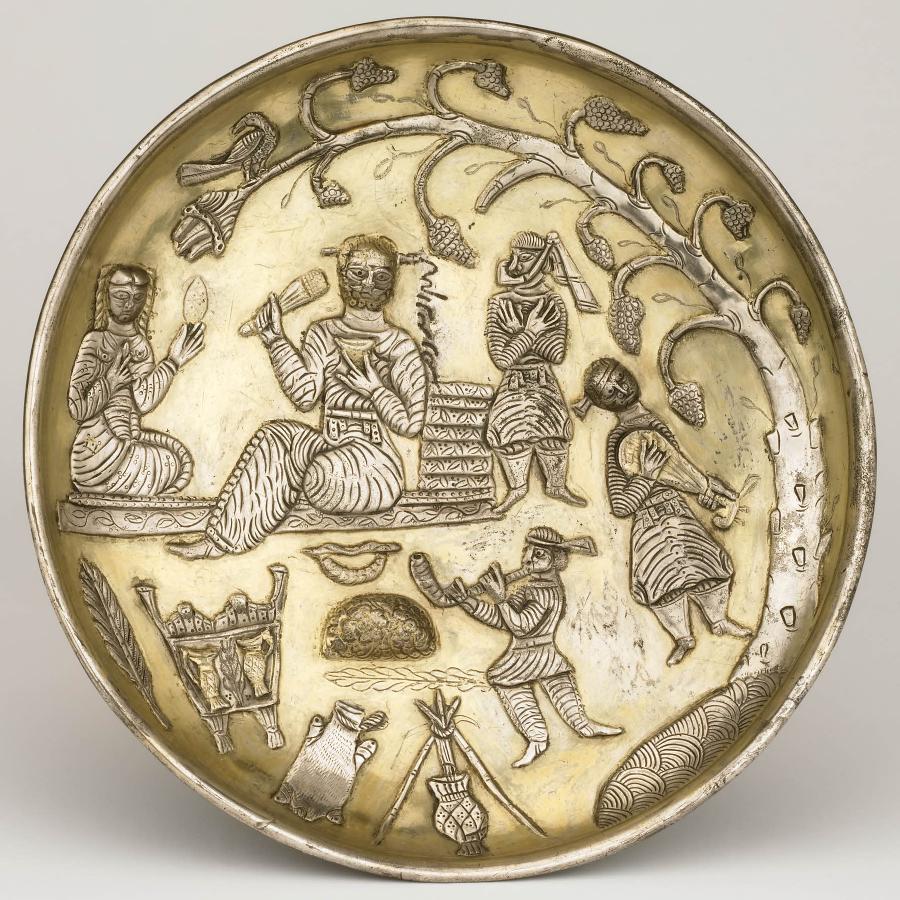
Try Amazon Audible Premium Plus and Get Up to Two Free Audiobooks
A Post Sasanian Banquet Scene, Tabaristan, 7th Century AD

A larger image of this Post Sasanian Banquet Scene, Tabaristan, 7th Century AD


Object type: dish
Museum number: 1963,1210.3
Description: Dish, with foot-rim. Made of gilded silver and decorated on the interior with relief decoration of a ruler in Sasanian costume reclining on a couch, surrounded by attendants, musicians and items essential for an outdoor banquet: a vine hung with ripe grapes, a water-bottle made from the skin of a whole animal, wine jugs in a cooler and a pot suspended over a fire.
Culture/period: Early Islamic
Date: 7thC-8thC
Production place: Made in: Tabaristan, North Iran, Mazandaran (province)
Excavated/Findspot: Tabaristan, North Iran, Mazandaran (province)
Materials: silver, gold
Technique: gilded
Dimensions:
Diameter: 19.7 centimetres
Height: 4 centimetres
Inscriptions:
Inscription Script: Pahlavi
Inscription Language: Persian
Inscription Translation: Anushzad
Curator's comments:
Bivar reads the inscription as Khorezmian and giving the weight of the bowl. Blurton, 1997: During the first century of Islam, vessels reflected earlier cultural traditions of the area in which they were made. Tabaristan was famous for silver vessels decorated in relief with scenes derived from the iconography of the Sasanian Empire. Hundreds of vessels were sent to the Caliphal court at Damascus and then to Baghdad where their beauty was celebrated in contemporary poetry.
British museum 1963,1210.3
A Post-Sasanian plate in the British Museum, which Ghirshman dates in the seventh century A.D. shortly after the fall of the dynasty, represents a figure in a banquet scene clad in a girdle with short straps studded with metal circles. The stylization of the drapery and the heavy square faces of the figures are closer to Central Asian than Persian prototypes. Perhaps the plate was made on the eastern borders of Iran which would account for the presence here of a Central Asian type of belt.
Elsie Holmes Peck, The Representation of Costumes in the Reliefs of Taq-i-Bustan. Artibus Asiae, Vol. 31, No. 2/3, 1969, Fig. 16.
D. A. Smirnoff, Argenterie orientale, St Petersburg, 1909, Pl. XXXVII, no. 66, Plate of Banquet scene. VII century A.D. British Museum
Although Persia was conquered by the muslims, Tabaristan remained independant until annexed by the Abbasid Caliphate in 765AD.
The Bavand dynasty (also spelled Bavend), or simply the Bavandids, was an Iranian dynasty that ruled in parts of Tabaristan (Mazandaran) in what is now northern Iran from 651 until 1349, alternating between outright independence and submission as vassals to more powerful regional rulers.
Je voudrais attirer l'attention sur une particularité vestimentaire des personnages de cette coupe: aussi bien le prince que ses serviteurs portent une ceinture composée de plusieurs éléments fixés sur une courroie. Cette ceinture n'est pas sassanide, elle est turque de Mongolie et d’Altaï, celle des Kirguizs, des Avares, des Alana-Khazares, bref une ceinture des nomades « depuis le Kazakastan jusqu'en Hongrie, et depuis l'Ossétie jusqu’à la Viatka-Kama et la Volga-Oka ». Les plus anciennes furent mises au jour dans les tombes du Ve - VIe siècle, sur l'Yénisséï, en Sibérie du Sud et en Mongolie. En Occident, elles n'ont pas de prototype. Plus tard, vers le VIe - VIIe siécle, elles prirent une très large extension.21 Les multiples plaques qui composaient ces ceintures servaient à y attacher des amulettes ou de petites bourses.
21 S. V. Kisselev, Histoire ancienne de la Sibérie du Sud, 1949, p. 249 (en russe).
Source: p. 63, R. Ghirshman, “Notes iraniennes V. Scènes de banquet sur l’argenterie sassanide,” Artibus Asiae 16, 1953, pp. 51-76.
I would like to draw attention to a clothing peculiarity of the characters in this dish: both the prince and his servants wear a belt made up of several elements attached to a strap. This belt is not Sassanid, it is Turkish from Mongolia and Altai, that of the Kirghiz , the Avars, the Alana-Khazars, in short a belt of nomads “from Kazakstan to Hungary, and from Ossetia, up to Viatka-Kama and Volga-Oka”. The oldest were unearthed in tombs from the 5th - 6th century, on the Yenisei, in southern Siberia and in Mongolia. In the West, they don't have a prototype. Later, around the 6th-7th centuries, they have a very long extension.21 The multiple plaques that made up these belts were used to attach amulets or small purses.
21 S. V. Kisselev, Ancient History of Southern Siberia, 1949, p. 249 (in Russian). [in French]